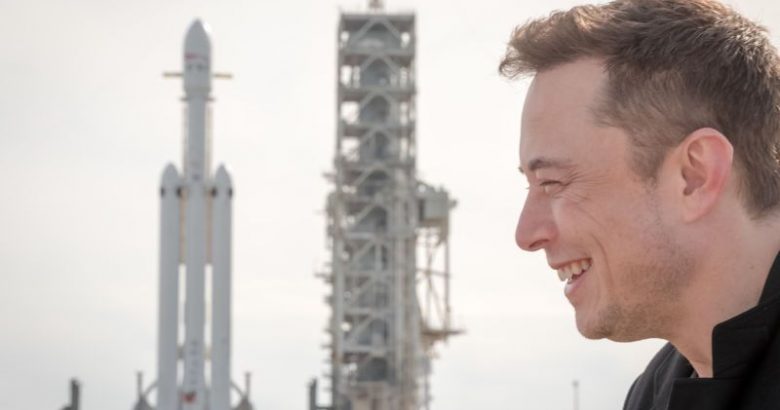
Falcon Heavy Animation
KENNEDY SPACE CENTER, Fla. — Sign up for the Science Times newsletter and sync your calendar with the solar system.
From the same pad where NASA launched rockets that carried astronauts to the moon, a big, new American rocket arced into space on Tuesday. But this time, NASA was not involved. The rocket, the Falcon Heavy, was built by SpaceX, the company founded and run by the billionaire entrepreneur Elon Musk.
The launch of this turbocharged version of the workhorse Falcon 9 rocket, which has been carrying cargo to space for years, marks an important milestone in spaceflight, the first time a rocket this powerful has been sent into space by a private company rather than a government space agency.

Elon Musk, the founder of SpaceX, at Launch Pad 39A at the Kennedy Space Center in Florida on Monday, where the Falcon Heavy rocket is expected to launch on Tuesday afternoon.CreditTodd Anderson for The New York Times
The rocket carried a playful payload: Mr. Musk’s red Roadster, an electric sports car built by his other company, Tesla. Strapped inside the car is a mannequin wearing one of SpaceX’s spacesuits. They are expected to orbit the sun for hundreds of millions of years.
The success gives SpaceX momentum to begin developing even larger rockets, which could help fulfill Mr. Musk’s dream of sending people to Mars. To do that, he has described a new-generation rocket called B.F.R. (the B stands for big; the R for rocket) that might be ready to launch in the mid-2020s. The Falcon Heavy’s maiden flight makes pursuit of the goal more plausible.
Mr. Musk’s visions include humans living both on Earth and Mars. He’s part of a new generation of entpreneurial space pioneers that includes Jeffrey P. Bezos, the founder of Amazon, who has said millions of people living in space is one of the goals driving his rocket company, Blue Origin. Planetary Ventures, an American company with a large investment from Luxembourg, hopes to mine asteroids for profit. Moon Express, based in Florida, sees a business in providing regular transportation to and from the moon.
GRAPHIC
SpaceX Launches Falcon Heavy
SpaceX successfully launched its newest rocket, the Falcon Heavy, on Tuesday.

For now, the Heavy will enable SpaceX to compete for contracts to launch larger spy satellites, and some experts in spaceflight are encouraging NASA to use private rockets like the Heavy instead of the gigantic and more expensive rocket, the Space Launch System, that is currently being developed in part to take astronauts back to the moon.
“It basically gives them another tool in their toolbox for accomplishing the space community’s goals,” said Phil Larson, an assistant dean at the University of Colorado’s engineering school who previously worked as a senior manager of communications and corporate projects at SpaceX.
Although delayed by high-altitude winds, the countdown proceeded smoothly, without any of the glitches that have bedeviled the maiden launch of new rockets.

The Heavy roared to life, a plume of smoke and steam shooting sideways from the launchpad. It rose from the pad, with an impossibly bright glare of 27 engines beneath it.
Then a thunderous roar, traveling at the speed of sound, rolled over the spectators.
The spacecraft will journey through Earth’s Van Allen radiation belt over the coming hours. If it succeeds, Mr. Musk’s sports car will head away from Earth onto an elliptical orbit around the sun that extends as far out as Mars’s orbit.
Just over three minutes after it blasted off, the most suspenseful part of the flight was over, as the boosters dropped off and the second stage continued into Earth orbit.
Sync your calendar with the solar system
Never miss an eclipse, a meteor shower, a rocket launch or any other astronomical and space event that’s out of this world.

Eight minutes after launch, the Cape Canaveral area was rocked by thunderous sonic booms as the two side boosters returned for a vertical landing. In the past few years, SpaceX has figured out how to routinely bring a booster stage back in one piece to fly again on future flights.
Since 2010, the company has been sending the smaller Falcon 9 rocket into orbit, deploying satellites and carrying cargo to crews aboard the International Space Station. The company has disrupted the global launch business with its lower prices and reusable boosters.
The Falcon Heavy is capable of lifting 140,000 pounds to low-Earth orbit, more than any other rocket today. Because all three boosters are recovered to fly again, a Falcon Heavy launch costs not much more than one by the company’s existing rocket, Mr. Musk said. SpaceX lists a price of $90 million for a Falcon Heavy flight, compared with $62 million for one by Falcon 9.
However, the market for the Heavy is smaller than what Mr. Musk envisioned when he announced the development of the rocket in 2011. Back then, he expected that SpaceX’s launches would be evenly split between Falcon 9s and Heavies.
But the development of the Heavy took years longer than anticipated — the central booster had to be redesigned to withstand the stresses of the powerful side boosters — and with advances in miniaturization, the trend is toward smaller satellites. SpaceX also boosted the capability of the Falcon 9, which now can launch many of the payloads that would have originally required a Heavy.
In addition to its central booster, the Falcon Heavy was equipped with two additional side boosters that essentially tripled its power at liftoff. While the Heavy uses many of the same components as the Falcon 9, Mr. Musk had cautioned that failures during a test flight would not be surprising. In particular, he worried about complex buffeting of air flowing past the boosters, which is difficult to predict even with the most sophisticated computer simulations.


